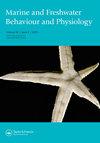Behavioral responses of northern crayfish (Faxonius virilis) to conspecific alarm cues and predator cues from smallmouth bass (Micropterus dolomieu)
IF 0.9
4区 生物学
Q3 MARINE & FRESHWATER BIOLOGY
Marine and Freshwater Behaviour and Physiology
Pub Date : 2020-01-02
DOI:10.1080/10236244.2020.1717338
引用次数: 5
Abstract
ABSTRACT While the ability for crayfish to detect visual and chemical cues is well documented, relatively few studies have probed the behavioral responses of crayfish to cues from key predators that they encounter in natural environments. Therefore, we examined how northern crayfish (Faxonius virilis) (Hagen 1870) responded to (1) alarm cues from conspecifics versus chemical cues from smallmouth bass (Micropterus dolomieu) (Lacepéde 1802), (2) varying concentrations of alarm cue from conspecifics, and lastly (3) smallmouth bass visual cues, chemical cues, and a combination of the two. We found that crayfish reduced walking activity in the presence of alarm cues. Chemical cues from smallmouth bass were also capable of eliciting a behavioral response, both alone and when paired with visual cues. Understanding the behavioral mechanisms by which crayfish respond to predatory fish is important to managing freshwater systems in the context of ongoing human- and climate-aided range expansions of both taxa.北方小龙虾(Faxonius virilis)对小嘴鲈鱼(Micropterus dolomieu)同种警报和捕食者信号的行为反应
虽然小龙虾探测视觉和化学线索的能力已经得到了很好的证明,但相对较少的研究探讨了小龙虾在自然环境中对主要捕食者的线索的行为反应。因此,我们研究了北方小龙虾(Faxonius virilis) (Hagen 1870)对(1)同种鱼发出的警报信号与来自小嘴鲈鱼(Micropterus dolomieu) (lacepde 1802)发出的化学信号的反应;(2)同种鱼发出的不同浓度的警报信号;最后(3)小嘴鲈鱼发出的视觉信号、化学信号以及两者的结合。我们发现小龙虾在有警报提示的情况下会减少步行活动。来自小口鲈鱼的化学线索也能引起行为反应,无论是单独的还是与视觉线索配对的。了解小龙虾对掠食性鱼类做出反应的行为机制,对于管理淡水系统具有重要意义,因为人类和气候都在不断扩大这两个分类群的活动范围。
本文章由计算机程序翻译,如有差异,请以英文原文为准。
求助全文
约1分钟内获得全文
求助全文
来源期刊

Marine and Freshwater Behaviour and Physiology
生物-海洋与淡水生物学
CiteScore
2.10
自引率
0.00%
发文量
9
审稿时长
>12 weeks
期刊介绍:
Marine and Freshwater Behaviour and Physiology is devoted to the publication of papers covering field and laboratory research into all aspects of the behaviour and physiology of all marine and freshwater animals within the contexts of ecology, evolution and conservation.
As the living resources of the world’s oceans, rivers and lakes are attracting increasing attention as food sources for humans and for their role in global ecology, the journal will also publish the results of research in the areas of fisheries biology and technology where the behaviour and physiology described have clear links to the contexts mentioned above.
The journal will accept for publication Research Articles, Reviews, Rapid Communications and Technical Notes (see Instructions for authors for details). In addition, Editorials, Opinions and Book Reviews (invited and suggested) will also occasionally be published. Suggestions to the Editor-In-Chief for Special Issues are encouraged and will be considered on an ad hoc basis.
With the goal of supporting early career researchers, the journal particularly invites submissions from graduate students and post-doctoral researchers. In addition to recognising the time constraints and logistical limitations their research often faces, and their particular need for a prompt review process, accepted articles by such researchers will be given prominence within the journal (see Instructions for authors for details).
 求助内容:
求助内容: 应助结果提醒方式:
应助结果提醒方式:


